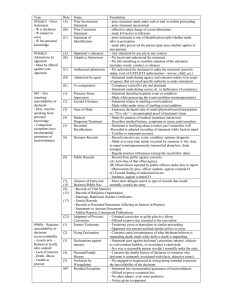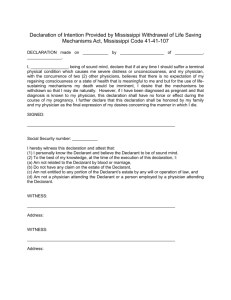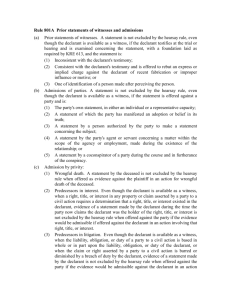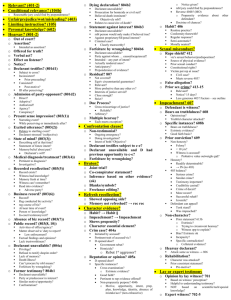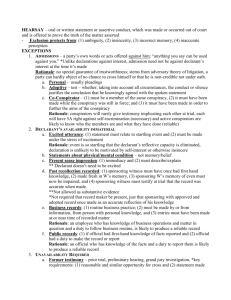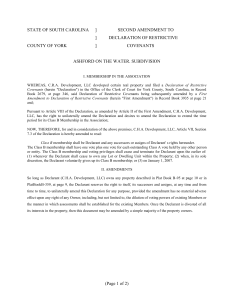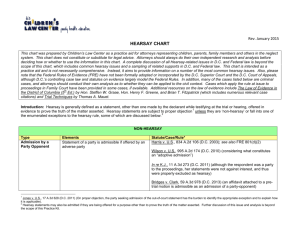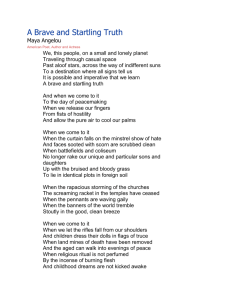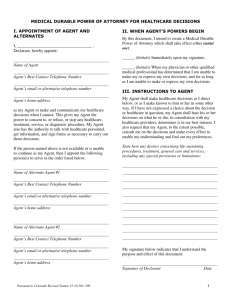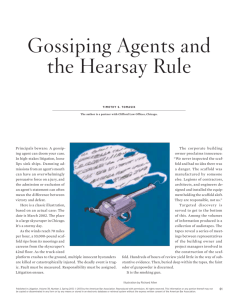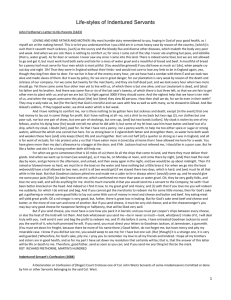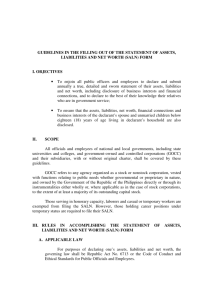Bar Exam Essay Writing Using IRAC
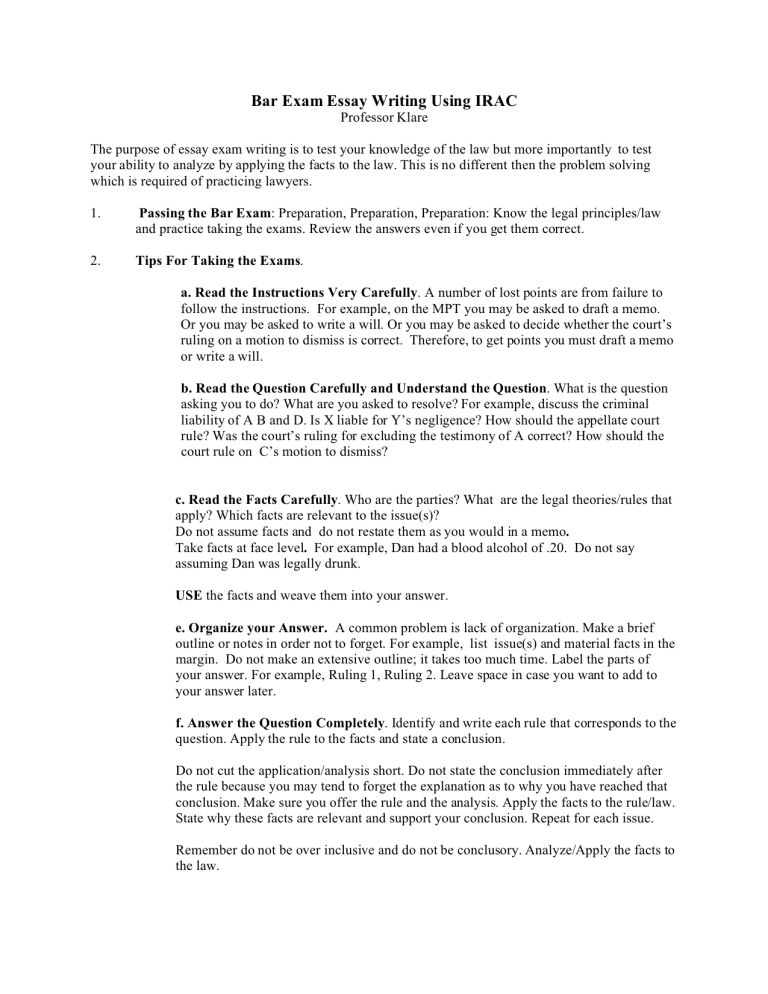
1.
2.
Bar Exam Essay Writing Using IRAC
Professor Klare
The purpose of essay exam writing is to test your knowledge of the law but more importantly to test your ability to analyze by applying the facts to the law. This is no different then the problem solving which is required of practicing lawyers.
Passing the Bar Exam : Preparation, Preparation, Preparation: Know the legal principles/law and practice taking the exams. Review the answers even if you get them correct.
Tips For Taking the Exams .
a. Read the Instructions Very Carefully . A number of lost points are from failure to follow the instructions. For example, on the MPT you may be asked to draft a memo.
Or you may be asked to write a will. Or you may be asked to decide whether the court’s ruling on a motion to dismiss is correct. Therefore, to get points you must draft a memo or write a will.
b.
Read the Question Carefully and Understand the Question . What is the question asking you to do? What are you asked to resolve? For example, discuss the criminal liability of A B and D. Is X liable for Y’s negligence? How should the appellate court rule? Was the court’s ruling for excluding the testimony of A correct? How should the court rule on C’s motion to dismiss?
c. Read the Facts Carefully . Who are the parties? What are the legal theories/rules that apply? Which facts are relevant to the issue(s)?
Do not assume facts and do not restate them as you would in a memo .
Take facts at face level . For example, Dan had a blood alcohol of .20. Do not say assuming Dan was legally drunk.
USE the facts and weave them into your answer.
e. Organize your Answer. A common problem is lack of organization. Make a brief outline or notes in order not to forget. For example, list issue(s) and material facts in the margin. Do not make an extensive outline; it takes too much time. Label the parts of your answer. For example, Ruling 1, Ruling 2. Leave space in case you want to add to your answer later.
f.
Answer the Question Completely . Identify and write each rule that corresponds to the question. Apply the rule to the facts and state a conclusion.
Do not cut the application/analysis short. Do not state the conclusion immediately after the rule because you may tend to forget the explanation as to why you have reached that conclusion. Make sure you offer the rule and the analysis. Apply the facts to the rule/law.
State why these facts are relevant and support your conclusion. Repeat for each issue.
Remember do not be over inclusive and do not be conclusory. Analyze/Apply the facts to the law.
g. Don’t waste time by repeating yourself. h. Answer the question(s) asked. Do not answer questions not asked.
I. Use the language of the law.
j. Allocate your time accordingly.
k. Organize your answers, brief outline first. l. Be clear and concise
M. Write legibly.
3. Using IRAC 1 This is more then just a helpful format but also a process to use for analyzing and organizing your answers.
You must KNOW the RULES: memorize the basic definitions and the elements of the rules for each subject tested. You may want to make flash cards. For example, write excited utterance on the front of a
3x 5 card. On the back write the definition.
Hearsay exception; availability of declarant immaterial. A statement relating to a startling event or condition made while the declarant was under stress of excitement caused by the event or condition. FRE 803(2)
Proponent of exception must establish: (1) occurrence of startling event; (2) that declarant made statement while under stress of excitement caused by event; and (3) that declarant's statement relates to startling event.
Use the following fact pattern to analyze under IRAC your flash card definition. The Declarant is walking down the street and reports to the police officer, five minutes after a car crashes, “The car swerved towards me and it had to be going 50 miles per hour when it hit the retaining wall.” Is the court’s ruling that declarant’s statement was inadmissible, correct? See suggestions below.
ISSUE: Know the law. What is the legal question/theory/controversy presented by the facts? Then spot the issue. If multiple issues pick an issue, organize the answer and start with the first issue to address.
For example, under these facts the issue is whether ..... state facts that suggest a startling event and the timing of the event etc. for the declarant. Issue spotting requires that you understand the question being asked and know legal rules relevant to a problem. Repeat the process if there are any issues or sub issues in the question.
Rule: Once you have stated the issue write down the applicable rule. State the entire rule if there are components. For example, see above three elements for excited utterances. Or the law of negligence has four elements: duty, breach, causation, and damages. Break the relevant rule into its components and discuss each element separately. Explain the relevant terms and concepts for the rule, e.g., forseeability.
Include enough of the rule for your analysis of the facts in controversy.
1 Many of you may not consciously use this formula but it helps as a framework the elements of
IRAC must be present for a comprehensive answer which gets you points.
Apply each element to relevant facts. Describe and explain how these facts lead to your conclusion. State or describe the rule accurately and precisely to avoid missing an issue that is present or discussing an issue that is not contained in the question. For example, the measure of damages for injuries to real property is the difference between the market value of the property immediately before and immediately after the injury.
Another example of a rule is the definition of burglary. At common law a burglary is the breaking and entering of a dwelling at night with the intent to commit a felony therein. Thus, there are five elements for common law burglary. You need to apply to the facts and see which are present and which are not.
Application: Analysis or application of the correct law to the facts is the most important component of exam writing. Divide the rule into its components. Look at the issues, make your arguments by applying the facts from the question to the applicable rules and finally state a conclusion.
Explain how these facts can be interpreted. Explain the legal significance or consequence of each relevant fact. For our excited utterance example, is a car approaching the declarant at 50 miles per hour a startling event? Is the car crash a startling event? Is the statement to the police officer made under the stress of excitement of the event? Is the 5 minute interval significant? If the facts changed to the statement was made a week later would it make a difference to the analysis? Does the declarant’s statement relate to the startling event?
If it is helpful think about using the word because since it reminds you that you need to explain the relationship of the rules to the relevant facts. Remember to explain how the elements of the rule/law apply to the facts of the problem. Use as many relevant facts as you can. Explain the relationship between the facts and your conclusion.
Use the facts accurately.
Do NOT invent or misconstrue facts. (Unless you are asked to do so).
Use policies if relevant.
Conclusion: State the conclusion concisely. Write a conclusion for each element and rule.
Do not use waffle words. Use the words like is liable, instead of can argue that, may be, perhaps. For example, the excited utterance of declarant is admissible as an exception to the hearsay rule. Therefore the court’s ruling was incorrect.
New York Bar Exam Essay Questions and Using IRAC
The essay question is not generally a restatement of the issue but a statement of the legal theory implied by the facts. Example: Is the courts ruling to exclude D’s statement correct?
Look to the legal theory in the facts. Thus the issue may be: Is the court’s ruling to exclude D’s statement as an excited utterance ( legal theory obtained from the facts) correct? State the rule and find the facts which support whether this exception to the hearsay rule is proper.
You must answer specific questions(s), generally asking for a single conclusion.
2
You must apply the relevant facts to the law to reach a logical conclusion.
2 Answering a law school exam generally is different. For example, you may be asked to discuss completely X, where you will be expected to argue both sides of an issue.
